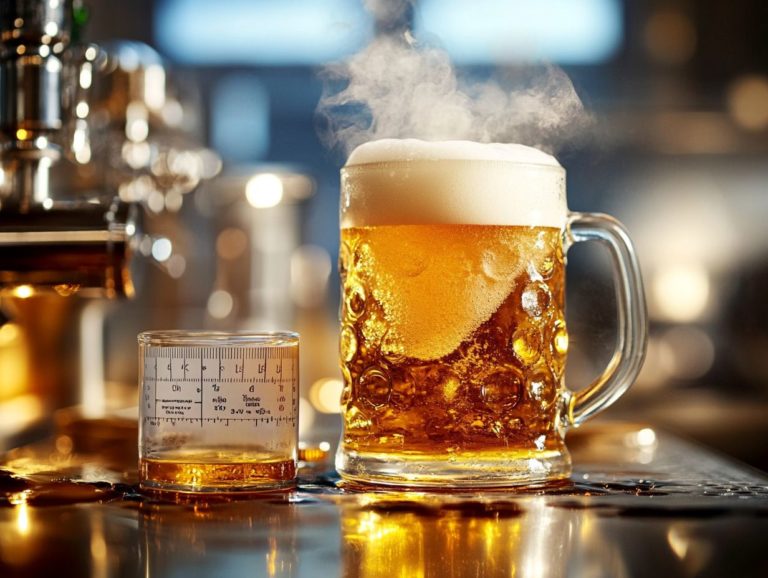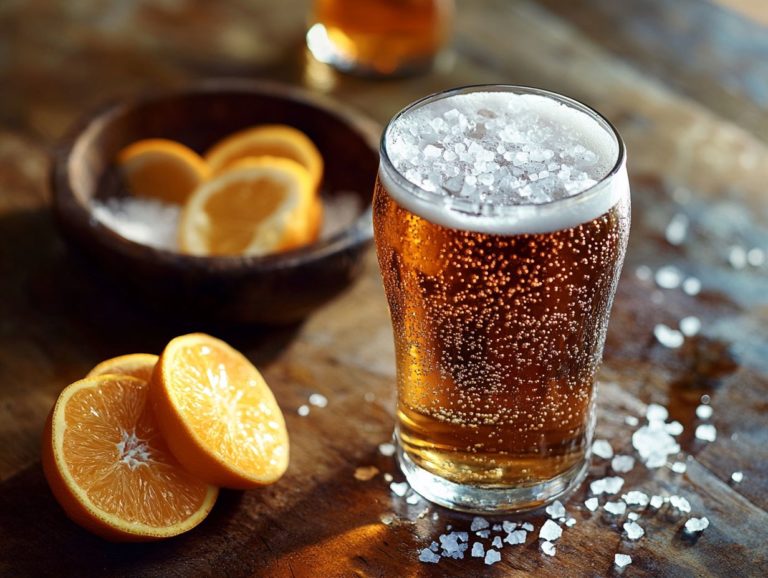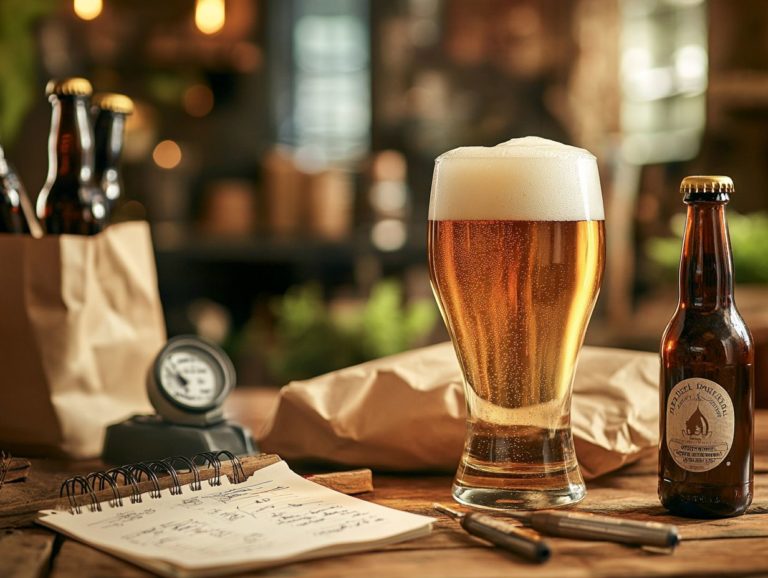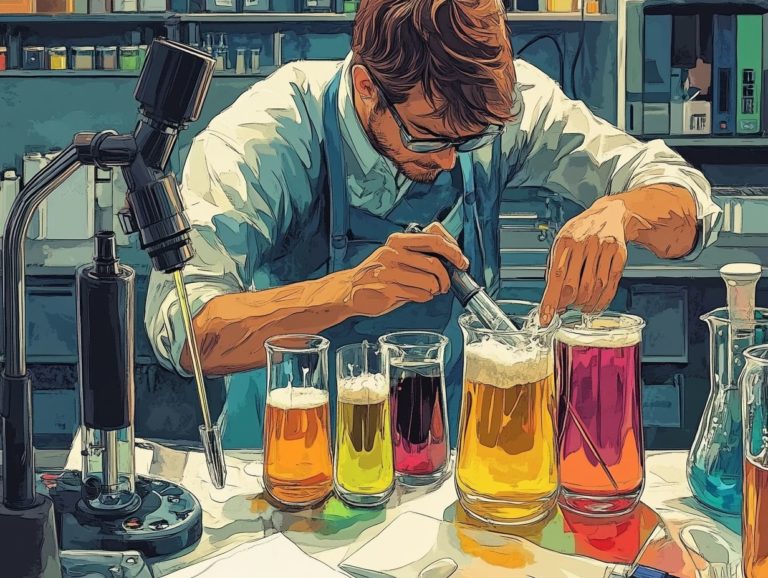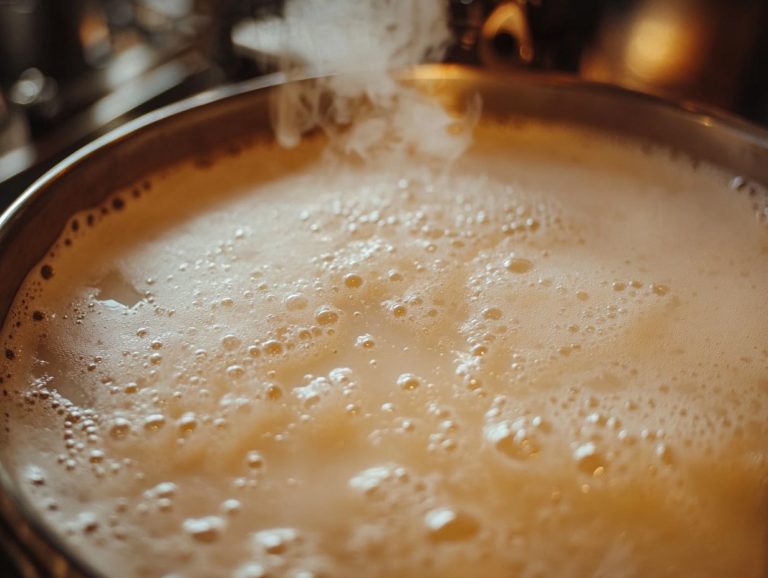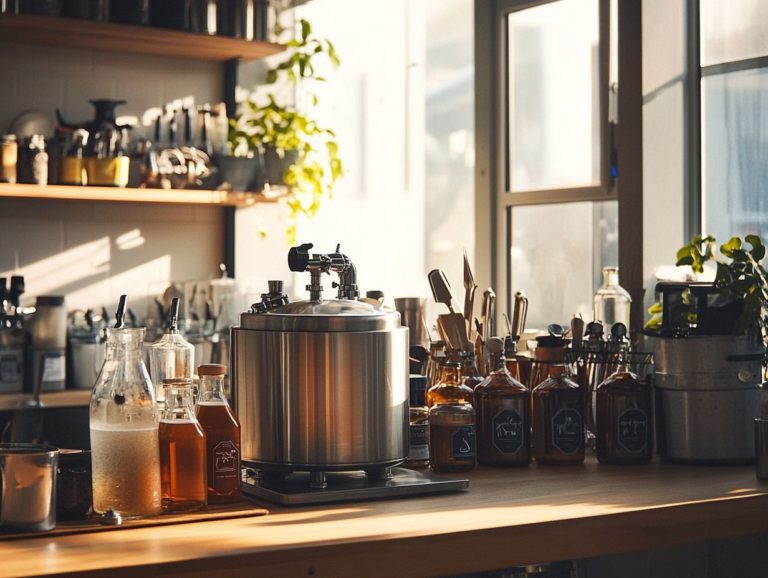How to Address Beer Age and Flavor Change
Beer enthusiasts often find themselves contemplating the effects of beer aging on their beloved brews. As time progresses, the flavors of a beer can transform, leading to fascinating new profiles or, regrettably, spoilage.
This discussion delves into the causes behind these flavor changes and provides valuable insights on how to store beer properly to preserve its quality. You’ll also learn how to identify if your beer has gone bad and discover tips for enhancing the flavor of aged brews by adding fresh ingredients.
Furthermore, you ll uncover the best practices for aging beer and which varieties truly flourish with time. Whether you re a casual drinker or a seasoned collector, understanding these concepts can take your beer experience to the next level.
Contents
- Key Takeaways:
- What Causes Beer to Age and Change Flavor?
- Proper Beer Storage: Preventing Flavor Changes
- How to Tell if Beer Has Gone Bad?
- How to Address Flavor Changes in Aged Beer?
- How Can You Prevent Flavor Changes in the Future?
- What Are the Best Practices for Aging Beer?
- Frequently Asked Questions
- How can I prevent beer from aging too quickly? Best Beer Storage Practices
- Can beer age be reversed? Understanding Oxidation Effects
- How can I enhance the flavor of aged beer? Exploring Aging Benefits
- What are some common misconceptions about aging beer? Debunking Myths
Key Takeaways:
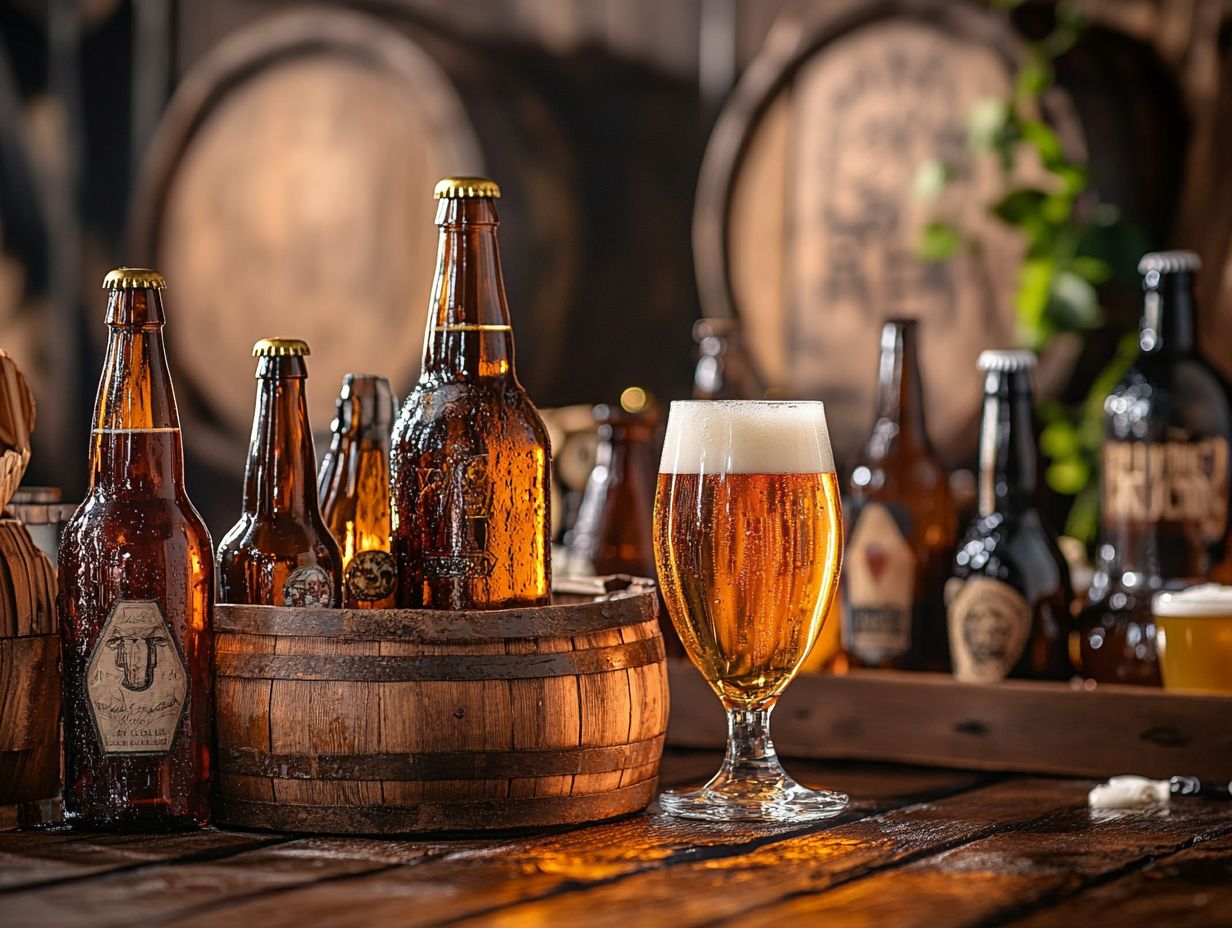
- Proper beer storage is crucial in preventing flavor change. Temperature, light, and carbonation maintenance should be considered when storing beer to maintain its taste.
- Spoiled beer can be identified by changes in appearance, smell, and taste. Aging can also cause changes in the flavor of beer, such as a decrease in hop bitterness and an increase in malt sweetness. The presence of off-flavor compounds can also indicate spoilage.
- To address flavor changes in aged beer, methods such as blending, adding fresh ingredients, and using specialized aging techniques can be employed. Selecting the right beer and storing it under optimal conditions are also vital for maintaining its flavor.
What Causes Beer to Age and Change Flavor?
Beer aging transforms the flavor profile of your favorite brew over time. This process is influenced by various factors, including chemical reactions within the beer and storage conditions like temperature and light.
Certain styles, such as barrel-aged beers and high ABV options like Imperial Stouts and Barleywines, are particularly noteworthy. As they age, these beers undergo oxidation processes that contribute to the emergence of complex flavors, often enhancing sweetness and malty notes through phenomena like the Maillard reaction and the production of melanoidins.
By diving into the nature of these changes, you can enhance your enjoyment of aged beer, honing in on flavor stability and richness.
What Factors Affect the Aging Process of Beer?
Several factors significantly influence the aging process of beer, impacting its overall quality and flavor stability. Pay close attention to key elements like storage conditions specifically temperature and light and the brewing techniques used during fermentation, as they are essential in determining how well your beer ages.
For instance, beers brewed with ester-heavy yeasts or dark malts will showcase different aging characteristics than those with low hops. Grasping these variables, including the role of volatile compounds, is crucial for anyone looking to delve into the complexities of aged beer.
The fermentation temperature plays a pivotal role in yeast metabolism, which in turn affects the production of various esters and phenolic compounds that develop throughout the aging process. Higher fermentation temperatures often lead to an uptick in ester production, introducing fruity flavors that may mellow and integrate beautifully into the beer’s profile over time.
Styles like Belgian Dubbel and Saison are perfect examples, as their yeast-driven characteristics can evolve with remarkable finesse as they age.
The choice of yeast strain greatly influences how your beer interacts with oxygen and reactive oxygen species during storage. Some yeasts are more sensitive to oxygen, while others thrive in its presence, leading to unique flavor transformations.
Darker styles, such as Imperial Stouts, benefit immensely from this interaction, revealing deeper notes of chocolate and coffee as they mature.
Proper Beer Storage: Preventing Flavor Changes
Aging benefits and proper beer storage are essential for maintaining flavor stability and preventing unwanted changes that may occur during the aging process. Key factors such as temperature, light exposure, and storage methods play crucial roles in preserving the quality of your beer, particularly for high ABV and dark-colored varieties that are especially sensitive to environmental conditions.
For example, barrel-aged beers and those that undergo bottle conditioning (a process where yeast is added to the beer in the bottle to promote carbonation) can suffer significantly if not stored correctly. By implementing best practices for beer storage, you can prolong the aging performance and guarantee a truly delightful tasting experience.
What Temperature Should Beer Be Stored at?
The ideal temperature for storing your beer is important for its aging process and flavor stability, with recommendations that vary depending on the beer style. For most beers, aim for a cool, dark environment between 45 F to 55 F.
However, for high ABV and complex brews like Imperial Stouts and Barleywines, slightly warmer conditions can actually enhance flavor development.
On the flip side, if you’re storing hoppy beers or those that emphasize freshness, it’s best to keep them at lower temperatures to preserve that vibrant hop aroma and prevent any off-flavors from creeping in.
Consistency in temperature is key; fluctuations can trigger undesirable chemical reactions that compromise the integrity of your beverage. For example, sudden spikes in temperature can speed up aging and lead to a loss of the intended flavor profile.
Conversely, if you store your beers too cold, you may hinder the maturation process, dulling the flavors that should beautifully evolve over time.
For collectors and enthusiasts, investing in proper storage solutions is essential. A stable environment is crucial to protect your valuable selections. Ultimately, by understanding these specific temperature ranges, you can significantly enhance your enjoyment of craft beers, ensuring that every sip reflects the brewer’s vision.
What Light Conditions Should Beer Be Stored in?
Light exposure is a critical factor that can significantly compromise your beer storage, leading to flavor changes that detract from your overall enjoyment. UV light, in particular, can trigger bad reactions in beer, resulting in off-flavor compounds that disrupt the intended flavor profile.
To avoid these bad reactions, storing your beer in dark environments or opaque containers is highly advisable, especially for light-colored or hop-forward beers that are particularly vulnerable to these detrimental changes.
When beer is exposed to light, especially ultraviolet rays, certain compounds within it such as compounds in hops that can affect flavor can degrade, producing a skunky aroma that resembles a light-struck flavor. This reaction is especially notorious in styles like pilsners and IPAs, where the delicate hop character is central to their identity.
To mitigate light exposure, you should consider using brown bottles or cans, as these materials significantly limit light penetration. Storing your beer in a cool, dark place will preserve its freshness, ensuring that its original flavors remain intact until you re ready to indulge, especially in hop-forward beers.
What are your favorite beer storage tips or experiences? Share with us!
How Should Beer Be Stored to Maintain Carbonation?
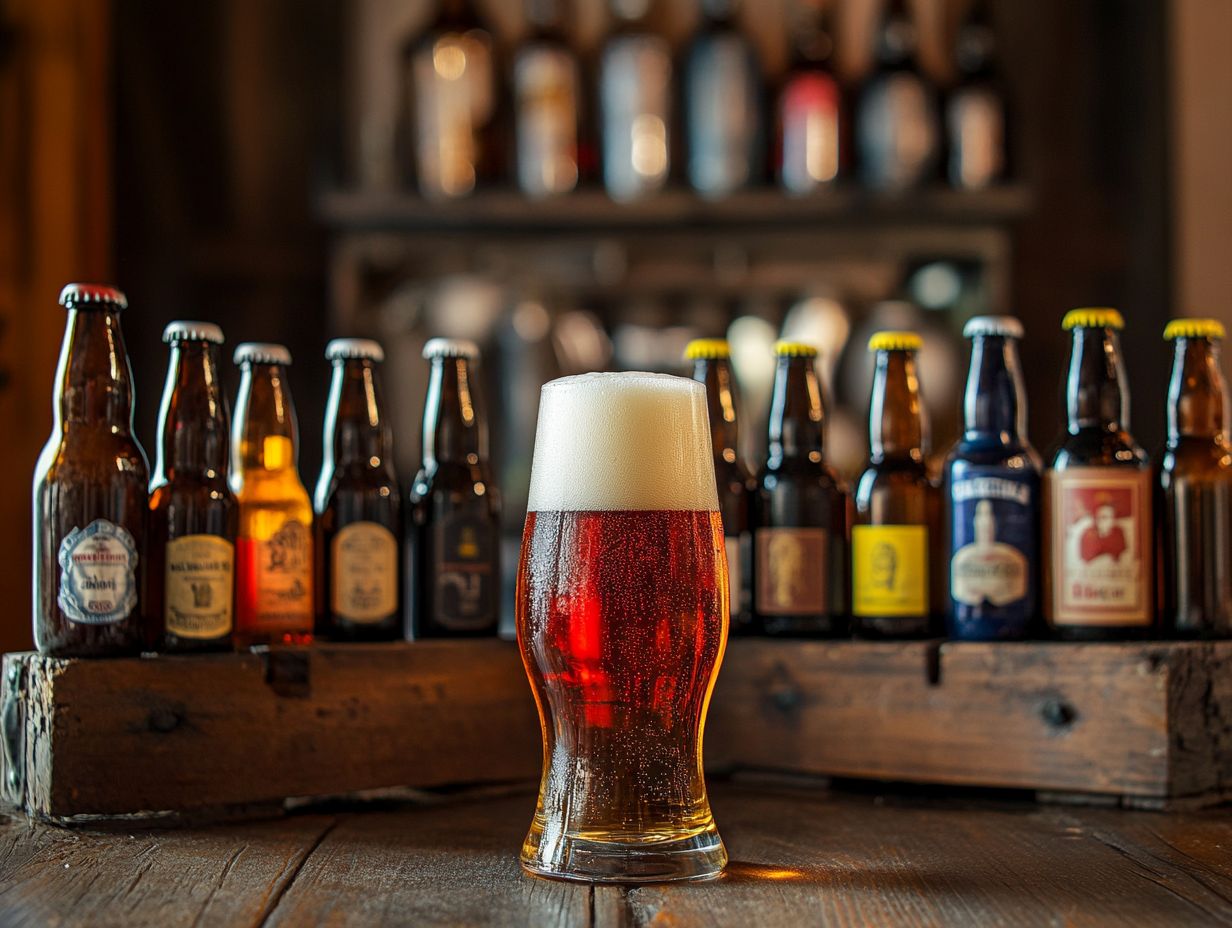
Maintaining carbonation in your beer is essential for preserving its intended mouthfeel and sensory perception. The right storage techniques play a significant role in achieving this, particularly in bottle conditioning. Bottle conditioning is the process of adding a small amount of sugar and yeast to beer before sealing it in a bottle, allowing carbonation to develop naturally.
For bottled beers, especially those that undergo bottle conditioning, you should always store them upright. This minimizes sediment drop and ensures that the yeast remains in suspension to carbonate the beer effectively. Keeping your beer within a consistent temperature range is key to preventing excess carbonation loss or over-carbonation, which can result in unwanted off-flavors or a disappointing flat taste.
Aiming for a constant temperature between 45 F and 65 F is advisable. Fluctuations can shock the yeast and impact carbonation levels. A dark environment is crucial since exposure to light can introduce undesirable flavors and lead to oxidation. Many enthusiasts invest in specialized beer fridges that offer precise temperature controls, greatly enhancing the aging process for certain styles.
By integrating these storage methods into your routine, you can ensure that your beer retains its effervescence and quality, resulting in a more enjoyable tasting experience.
How to Tell if Beer Has Gone Bad?
Identifying whether your beer has gone bad is essential for every beer lover. Expired beer can harbor off-flavor compounds that drastically impact its flavor profile and overall drinking experience.
Keep an eye out for key signs of spoiled beer, such as unexpected changes in aroma, taste, and appearance like haziness or unusual sediment. By assessing the beer’s sensory qualities its smell, taste, and visual characteristics you can determine whether it has aged gracefully or succumbed to unwelcome aging traits.
Mastering the art of identifying an aged-out beer will help you enjoy your brews at their peak. Timely consumption is crucial to ensure you savor every sip at its best.
What Are the Signs of Spoiled Beer?
You may notice several signs that indicate your beer has gone bad, often revealed through distinct alterations in aroma and flavor. Spoiled beer can emit an unpleasant smell, akin to cardboard or wet paper, a telltale sign of oxidation.
On the palate, it might develop sour or vinegar-like notes, hinting at off-flavor compounds from reactive oxygen species that suggest it s time to part ways with that brew rather than risk an unpleasant drinking experience.
You can also observe physical signs of deterioration; a beer that has turned can appear cloudy or showcase unusual sediment settling at the bottom of the bottle. Styles like hoppy IPAs and delicate wheat beers are particularly vulnerable to spoilage, as their flavor profiles make them more prone to oxidation processes.
To sidestep these issues, ensure you store your beer in a cool, dark place and consume it before the expiration date. This way, you can savor the sensory qualities that make for a truly refreshing drink, maintaining its flavor stability.
How Does the Flavor of Beer Change with Age?
The aging process can profoundly transform the flavor of beer, leading to the emergence of complex notes that may enhance or detract from its original profile. As time passes, oxidation processes introduce new aromas and tastes think caramel, sherry, and a sweet malty impression especially in high ABV beers such as Barleywines and Belgian ales.
However, not all changes are beneficial; some beers may take a turn for the worse if aged improperly. This highlights the importance of understanding how the aging process affects flavor development. Certain stouts, particularly imperial stouts, thrive with extended aging.
The roasted malt flavors mellow and harmonize, resulting in a smoother, richer profile. On the flip side, hop-forward styles like IPAs often lose their vibrant aromas and bitterness over time, as the hops degrade and oxidize. Lighter beers, such as pilsners, frequently lose their refreshing qualities and crispness, becoming somewhat lackluster after aging.
By grasping these nuances in how various styles respond to aging, you can make informed choices that elevate your tasting experience while steering clear of less enjoyable outcomes.
How to Address Flavor Changes in Aged Beer?
Addressing flavor changes in your aged beer is essential for both savoring and preserving the quality of your collection, particularly when you come across unexpected off-flavors or undesirable characteristics like acetaldehyde.
You can employ various methods to restore the flavor of aged beer, such as blending it with fresher brews, using flavor-enhancing additives, or adjusting the serving temperature to better showcase its intricate flavors.
By familiarizing yourself with these techniques and approaches, you can transform aging or flawed beer into a more enjoyable experience that delights your palate.
Can the Flavor of Aged Beer Be Restored?
Indeed, you can often restore or even enhance the flavor of aged beer through a variety of methods, allowing you to salvage bottles with flaws.
By blending aged beer with fresher brews, you can create a delightful balance that mitigates undesirable flavors. Flavor-enhancing additives like oak chips or spices can add interesting new flavors, while adjusting the serving temperature can help reveal hidden flavors and aromas that may have gotten lost in the aging process.
Such techniques can be particularly effective for homebrew beer, where careful adjustments can make significant improvements. For example, blending can be a remarkably effective strategy, particularly for barrel-aged stouts or sour beers.
This technique allows you to craft a harmonious flavor profile that highlights the best qualities of both the old and the new components. However, it requires a discerning palate to achieve the perfect balance, as not every combination will produce a desirable outcome.
Using oak chips can work wonders, imparting flavors reminiscent of fine wines and giving styles like barleywines an intriguing twist through the Maillard reaction. But proceed with caution too much wood influence can easily overshadow those delicate notes you want to shine through.
Don t forget to adjust serving temperatures for the best experience, especially with complex Belgian ales. Their nuanced flavors tend to emerge beautifully when warmed slightly.
By implementing these methods, you can achieve rewarding results, but be mindful; each technique affects different beer styles uniquely, so a thoughtful approach is essential.
What Methods Can Be Used to Improve the Flavor of Aged Beer?
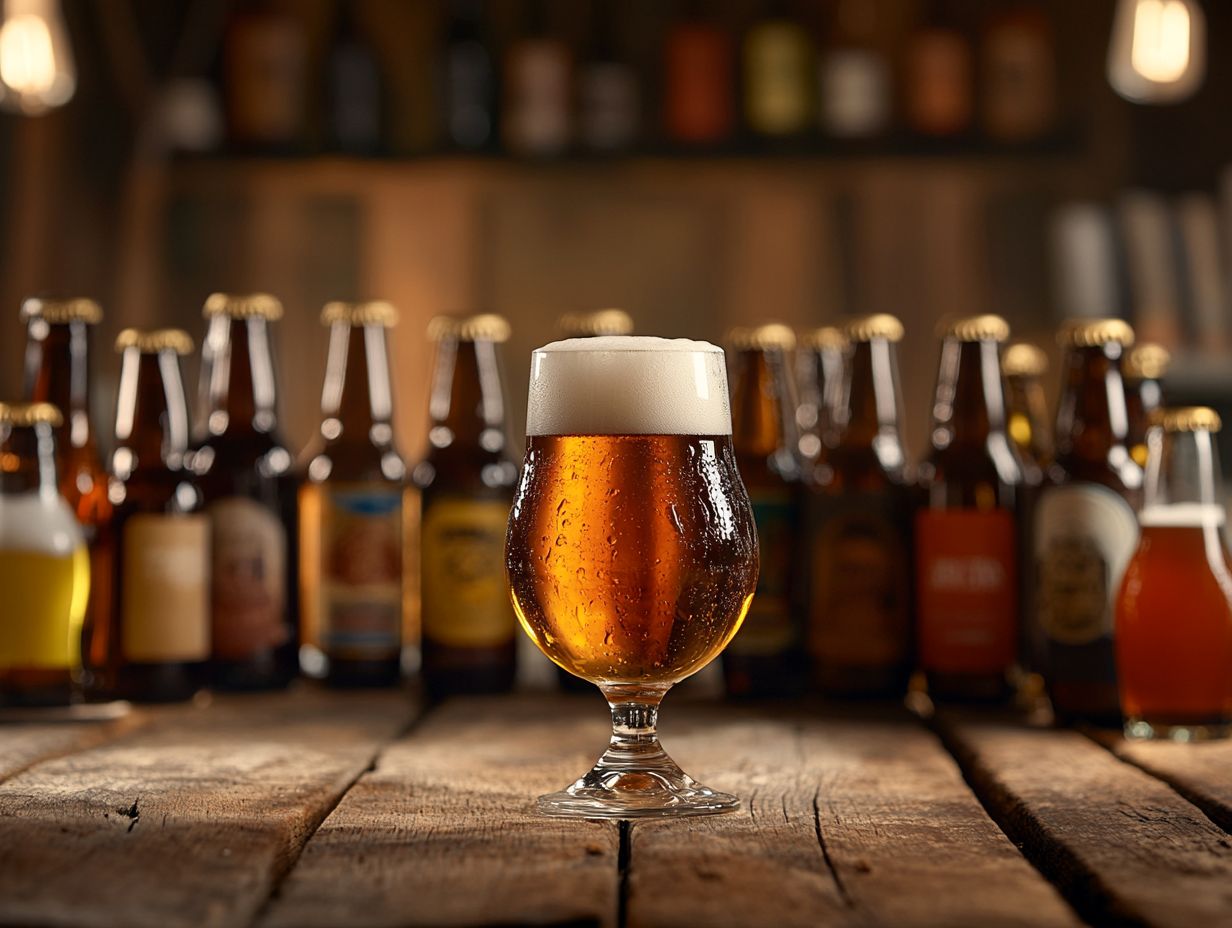
You have several methods at your disposal to enhance the flavor of aged beer, allowing you to elevate your tasting experience and mitigate any off-flavors that might have developed over time.
One popular approach is blending combining your aged beer with a fresher batch or a different style to achieve a more harmonious flavor profile.
Just like blending, barrel aging or incorporating flavor-enhancing additives like fruit or spices can introduce exciting new dimensions to your beer, enhancing its complexity and overall appeal.
This technique not only breathes new life into your beverage but can also create a delightful fusion of flavors, such as mixing a sour aged ale with a hoppy IPA. Barrel aging can impart unique characteristics; for instance, a stout aged in bourbon barrels may reveal enticing notes of vanilla and oak.
Adding fruits like cherries or blood oranges can contribute zest and freshness, particularly to aged lambics, allowing that delightful tartness to truly shine.
By employing these methods, you can elevate your aged brews, transforming potential shortcomings into standout highlights that capture the essence of true craftsmanship. Considering ester-heavy yeasts and their aging characteristics can further enhance the final product.
How Can You Prevent Flavor Changes in the Future?
To prevent flavor changes in your future aged beer, it’s essential to pay careful attention to storage conditions and brewing techniques that enhance flavor stability. By implementing best practices like temperature control, shielding your beer from light exposure, and using quality ingredients during brewing, you can significantly influence how well your beer ages and maintains its intended profile.
Opting for beer styles that have favorable aging characteristics such as those with dark malts or higher ABV will ensure a more enjoyable experience over time. Monitoring fermentation temperature and using fresh ingredients are also crucial steps in preserving the beer s quality.
Consistent temperatures throughout the aging process are crucial. Any fluctuations can lead to oxidation and affect the flavor profile. It s wise to store your beer upright to minimize contact with the cap, which can degrade and affect the taste.
Regularly checking humidity levels is another safeguard against unwanted mold or spoilage. The choice of packaging also matters using brown bottles or cans is vital for protecting your brew from light damage.
By combining these thoughtful storage and brewing practices, you can greatly enhance your chances of savoring a superbly aged beer that lives up to its original flavor promise.
What Are the Best Practices for Aging Beer?
Understanding the best practices for aging beer is essential for enthusiasts like yourself who wish to enhance flavor development and preserve the quality of your collection over time. This includes paying attention to brewing variables such as fermentation process and storage conditions.
Discover the amazing techniques for aging that will elevate your beer experience! You can achieve this by selecting the ideal storage conditions, utilizing high-quality ingredients, and carefully considering which beer styles are most suitable for aging.
Techniques like bottle conditioning a method where yeast is added to the bottle to help develop flavor and monitoring beer storage are integral to achieving the best aging performance. By implementing these best practices, you ll elevate your experience, allowing you to fully appreciate the complexity and nuances of aged beers, such as barrel-aged varieties, Belgian ales, and rich Imperial Stouts.
This includes understanding how volatile compounds and yeast metabolism contribute to the overall sensory perception of the beer.
Which Types of Beer Are Best for Aging?
Certain types of beer are particularly well-suited for aging, allowing you to experience the development of complex flavor profiles and enhanced quality over time. High ABV beers, such as Imperial Stouts and Barleywines, along with darker varieties and barrel-aged options, tend to age gracefully.
These beers benefit from oxidation processes that promote rich caramel flavors and deeper, malt-forward impressions. Belgian ales often showcase remarkable aging characteristics, evolving to produce unique aromas and tastes that enthusiasts eagerly seek.
Dark-colored beers and those with a robust malt backbone are often the best candidates for aging. These beers typically have a robust malt backbone and a higher alcohol content, both of which help preserve the integrity of the brew over time.
Styles like Quadrupels and Flanders Red Ales are especially noteworthy for their aging potential. Their complex interplay of malt sweetness and tartness creates a fascinating transformation as they mature, showcasing the benefits of aging out undesirable elements and enhancing malt-leaning flavor profiles.
The interaction between the hops and malt evolves, often improving the overall balance of the beer while enhancing fruity esters and spicy phenols. As a result, you’ll find that giving these particular brews time leads to a symphony of flavors that tells the story of their time in the bottle.
Try out these tips and share your favorite aged beers with fellow enthusiasts to create a sense of community and enjoyment!
Recommended Aging Conditions for Different Types of Beer
Recommended aging conditions vary by beer type, as different styles flourish in specific storage environments to achieve optimal flavor stability and development. Generally, you should aim to maintain a cool, dark space with stable temperatures to prevent the development of off-flavor compounds. However, keep in mind that certain beers, like hoppy IPAs and low hops beers, are best savored fresh. On the other hand, high alcohol by volume (ABV) dark beers require careful monitoring to ensure they age gracefully without developing off-flavors. Understanding what each beer style needs can enhance your aging experience immensely!
For instance, stouts and barleywines thrive when aged in controlled conditions. This allows their bold flavors, enhanced by yeasts that produce fruity flavors, to mature and meld beautifully over time. In contrast, lighter styles like pilsners and wheat beers typically lose their freshness, hop aroma, and hop character, making them unsuitable for long-term storage.
The ideal aging environment features minimal light exposure. It is also essential to maintain temperatures between 50-55 F to preserve the optimal flavor profiles and minimize oxidation processes. Meanwhile, sour ales can sometimes flourish in slightly warmer conditions. Minor variations in temperature can unlock complex flavor development, allowing volatile compounds and Brettanomyces, a type of yeast often used in sour beers that can add unique flavors, to enhance the aged beer.
By grasping the nuances of each type, you can ensure your beer matures gracefully, ultimately leading to a richer tasting experience.
How Long Should Beer Be Aged for Optimal Flavor? Aging Recommendations and Techniques
The ideal aging duration for beer varies significantly depending on the style and your personal tastes. Some beers reach their peak flavor after just a few months, while others may thrive with years of aging, benefiting from specific aging techniques.
High ABV options like Barleywines and Imperial Stouts often evolve beautifully over time, developing richer, more complex flavors. In contrast, hop-forward beers like NEIPA are generally best enjoyed fresh to retain their vibrant aromatic qualities. By understanding the desired flavor profile and aging characteristics of specific beers, such as those found in Belgian ales or beers brewed with Amarillo hops and Galena hops, you can make informed decisions about the right aging timeline.
For example, a well-crafted Belgian Quad might need a year or two to fully reveal its signature dark fruit and caramel notes, while a crisp American Pale Ale is best appreciated within weeks of its packaging date. Several factors influence these aging preferences, including carbonation levels, the ingredients used, and environmental conditions, such as temperature and light exposure, which can affect oxidation effects and the presence of reactive oxygen species.
Ultimately, recognizing the unique attributes of each beer style can greatly enhance your tasting experience. This deepens your appreciation for the intricate complexities and malt-leaning flavor found in various brews, especially barrel-aged beers.
Frequently Asked Questions
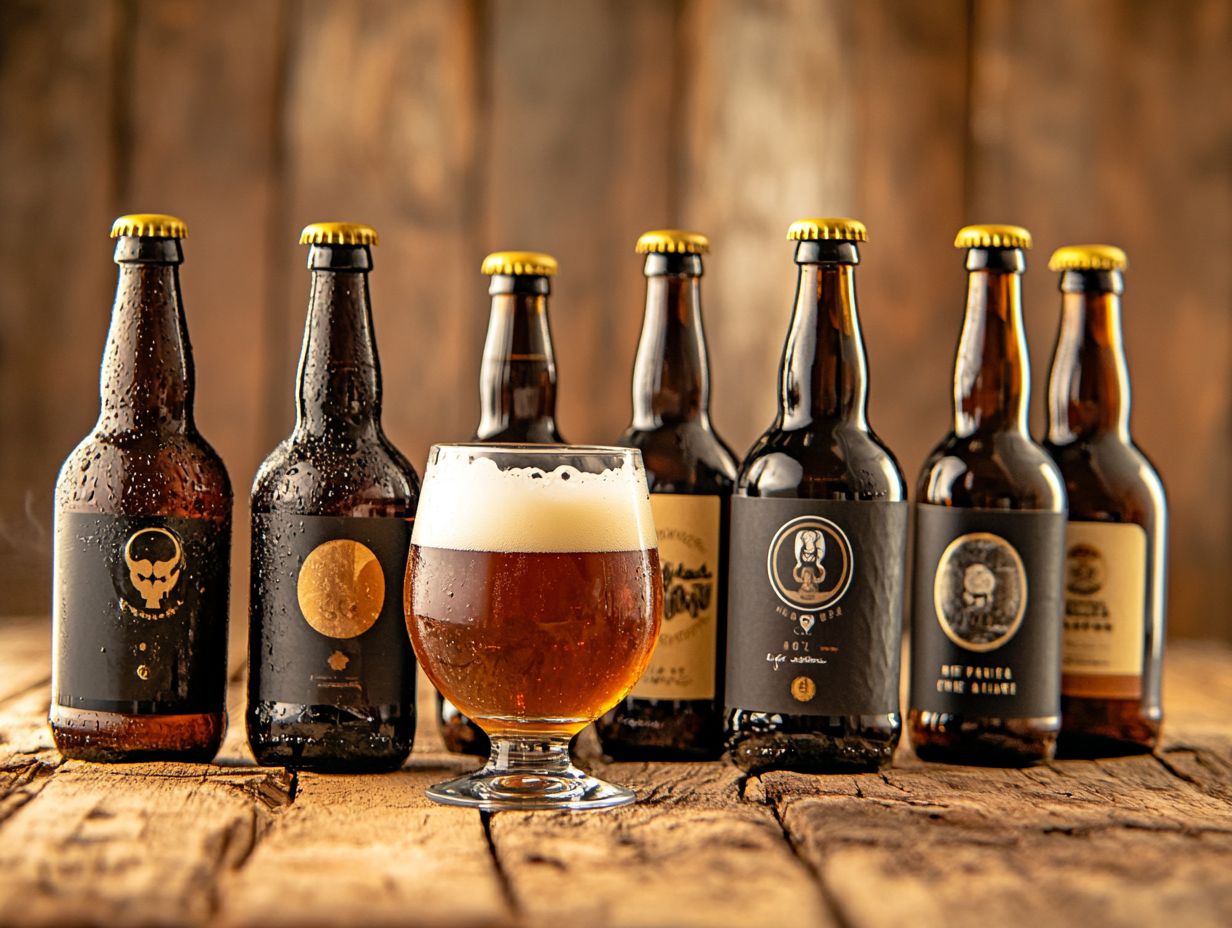
How does beer age affect its flavor? Understanding the Aging Process
As beer ages, its flavor can change due to various factors such as exposure to light, changes in temperature, and oxidation. These factors can cause the beer to develop off-flavors, lose its carbonation, experience sediment drop, and change in color and aroma.
The aging process affects yeast metabolism and the formation of melanoidins through the Maillard reaction.
What are some signs that a beer has aged too long? Identifying Aging Out
If a beer has aged too long, it may have a stale or cardboard-like taste. You might notice a flat or dull appearance, and a lack of aroma. The beer may also have a higher alcohol content due to evaporation of water, leading to a stronger, more intense flavor, which may not be desirable. This is often referred to as aging out.
How can I prevent beer from aging too quickly? Best Beer Storage Practices
To prevent your beer from aging too quickly, store it in a cool, dark place with a consistent temperature. Avoid exposing the beer to light and temperature fluctuations. These factors can accelerate aging and negatively impact taste.
Using proper beer storage techniques helps maintain taste and overall aging performance.
Can beer age be reversed? Understanding Oxidation Effects
Beer age cannot be reversed. However, there are steps to improve the flavor of aged beer. Store it in a cool, dark place, consume it before the “best by” date, and keep it away from heat and light sources.
Understanding oxidation effects and aging characteristics can help you enhance the flavor of aged beer.
How can I enhance the flavor of aged beer? Exploring Aging Benefits
If you have an aged beer with a less-than-desirable flavor, try these tips to transform its taste:
- Drink it at a colder temperature.
- Pair it with food.
- Add ingredients like fruit or spices for a unique flavor profile.
Try these techniques to unlock the hidden flavors in your aged beer!
What are some common misconceptions about aging beer? Debunking Myths
One common misconception is that all beer should be aged. In reality, only certain styles are meant to be aged. Some people believe that aging beer always improves its flavor. However, it can often have negative effects if not done properly.
Proper aging techniques and awareness of brewing variables are essential for achieving the best results.

